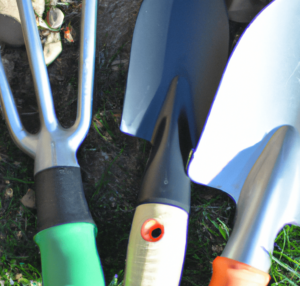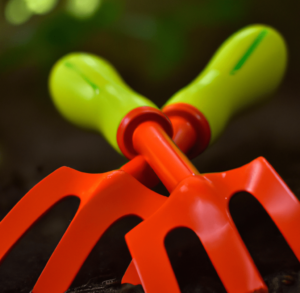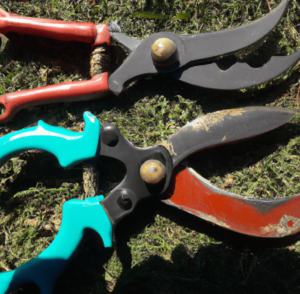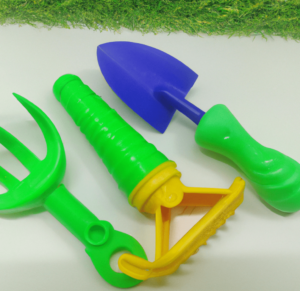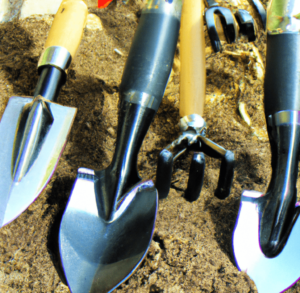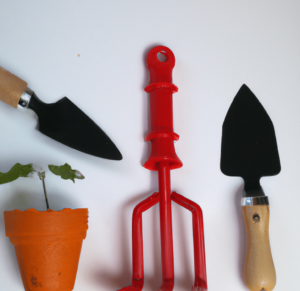Plant cultivation and growth take place in a garden or yard as part of gardening. It is a well-liked hobby for many people and a successful business for others. Raised bed gardening is a well-liked gardening technique in which plants are cultivated in a raised bed that has been filled with soil. Better drainage, soil management, and simpler access for planting and weeding are all made possible by this technique. However, it’s crucial to have the gardening tools for raised bed gardening if you want your outdoor space to succeed. Here’s everything you need to know! Essential Tools for Raised Bed Gardening
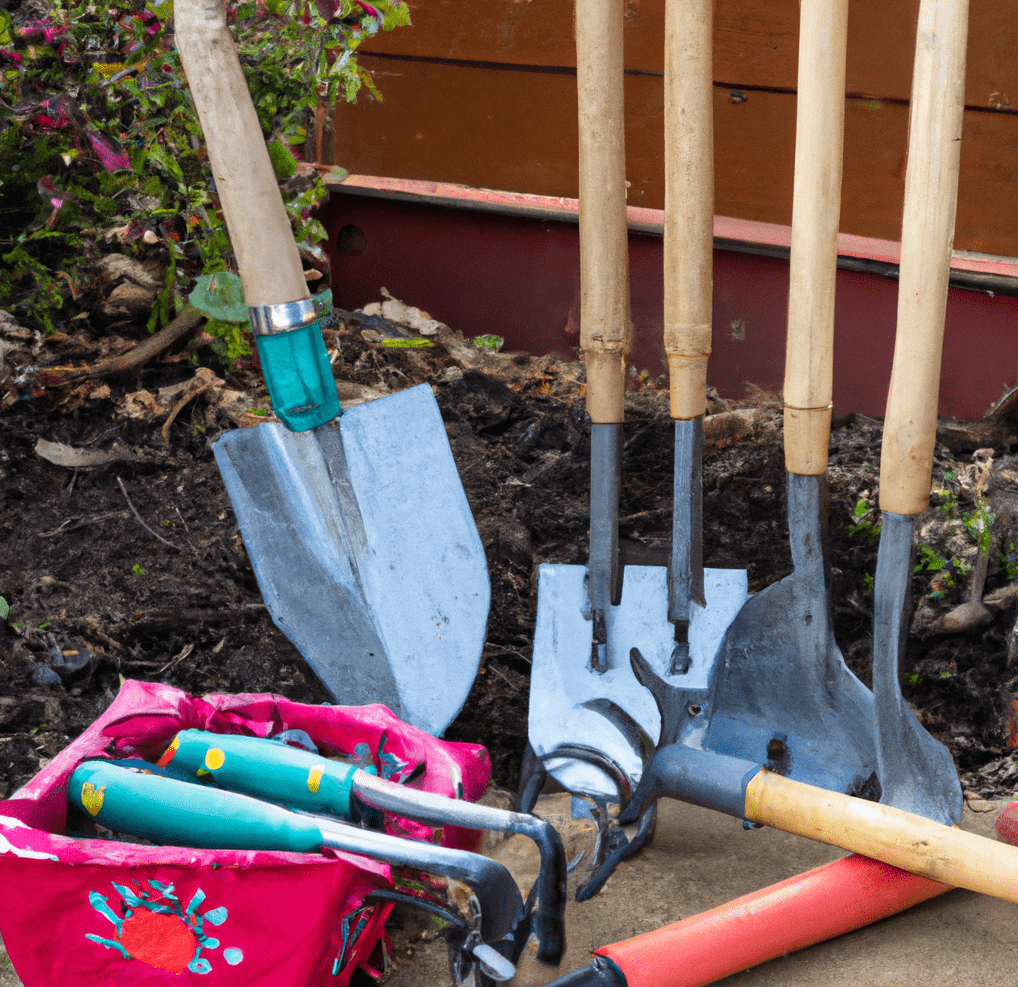
Some of the gardening tools for raised bed gardening fall under multipurpose tools and their uses while others are designed for one job:
- Hand trowel: In the garden, a hand trowel is a small, pointed-bladed tool used for digging and transplanting small plants. For raised bed gardening, it is crucial equipment because it makes it simple to sow and transplant your plants.
- Garden fork: To loosen and aerate the soil, use a garden fork, which has a long handle and pointed tines. Raised bed gardening requires it since you can use it to loosen the soil without harming the plant roots.
- Pruning Shears: Pruning shears are a sort of scissor-like tool used to shape plants, prune back dead or damaged plant parts, or remove unwelcome growth. They are necessary for raised bed gardening in order to keep your plants healthy and in good shape.
- Hand Cultivator: To get rid of weeds and aerate the soil surrounding your plants, use a hand cultivator, a portable tool with a forked blade. In order to maintain a healthy garden by keeping the soil loose and weed-free, it is crucial for raised bed gardening.
- Protective Gear: When you garden in a raised bed, you need to wear garden gloves to protect your hands from thorns, prickles, and blisters. Also, they help you keep a firm grip on your instruments, which makes it easier to use them.
You can take good care of your plants and maintain a healthy garden with the aid of these gardening tools for raised bed gardening. With the correct equipment, you may enjoy raised bed gardening and benefit from a plentiful crop.
Shovel
For any gardener, especially those who use raised bed gardening, a shovel is a need. It is a long-handled tool made for digging and moving soil, compost, and other materials. Its blade is flat with a slight curvature. The square-pointed shovel, though available in a variety of sizes and forms, is the one most frequently used gardening tools for raised bed gardening:
- They’re first used to loosen and dig up the soil in the garden bed. By doing this, you can ensure that the soil is ready for planting and that the plants have access to the nutrients they require to grow.
- Dirt, compost, and other items are shifted into the raised bed using shovels. This is crucial for building the raised bed and making sure the dirt is distributed evenly.
- The dirt and compost are combined using shovels. Making a healthy soil mixture that is rich in nutrients and encourages healthy plant growth depends on this.
- The raised bed is cleaned out using shovels to remove any dead plants or other plant debris. This keeps the garden bed tidy and limits the spread of disease and pests.
- Shovels are employed during agricultural harvesting. They can be used to gently remove root vegetables like beets and carrots from the ground.
A shovel’s various applications make it a necessary tool for establishing the garden bed, preserving the soil, and gathering harvests. A shovel is necessary for larger garden beds and tasks, even though hand trowels are wonderful for small-scale gardening.
Tips for Selecting the Right Shovel for Your Needs
Now that you know about gardening tools for raised bed gardening, here’s how to choose the best shovel:
- Raised bed size: The size of your raised bed will decide the size of the shovel you require, so keep that in mind. A larger shovel will work better if your raised bed is big. A smaller shovel would be more suited if your raised bed is smaller.
- Search for a pleasant handle: The shovel’s handle should be cozy to hold and simple to grasp. In order to avoid splinters and cracks, look for handles made of fiberglass or wood.
- Examine the blade: The shovel’s blade ought to be constructed from a sturdy material that won’t easily bend or break. Try to find a blade that is composed of steel or another sturdy metal.
- Take the shovel’s weight into account: Even while a hefty shovel might be more robust, it might be challenging to operate for long periods of time. Find a shovel that is manageable but also powerful enough for your needs.
- Consider the shovel’s blade shape: The shovel’s blade shape might dictate the type of task it is best suited for. A round-point blade is preferable for cutting through roots or chopping up tough dirt, while a square-point blade works well for digging and moving soil.
- Invest in quality: A higher-priced, better-quality shovel will serve you better and endure longer than one that is less expensive. Choose a shovel that is long-lasting and produced by a recognized company.
You can make sure you have the correct equipment for the job and make your gardening experience more fun and fruitful by taking these elements into account when choosing a shovel for raised bed gardening.
Hoe
A hoe is one of the gardening tools for raised bed gardening with a long handle that you can use to break up soil and get rid of weeds. It consists of a long handle and a head with a flat, blade-like surface that is angled at a right angle to the handle. The blade, which can be constructed from steel, aluminum, or other materials, is sharpened to increase its effectiveness.
A hoe is a versatile tool that can be used in raised bed gardening:
- Breaking up the dirt in the bed to make it easier to plant seeds and transplant seedlings is one of its main purposes. You can increase the soil’s capacity to absorb water and nutrients by hoeing the soil loose.
- In raised bed gardening, weeding is another task for a hoe. Weeds can be pulled out of the bed by cutting through the roots with the hoe’s blade. This is an effective alternative to using chemical herbicides to control weeds.
- A hoe can also be used to cultivate the soil around established plants and to cut furrows in the ground to plant seeds in. You can help your plants be healthier and more productive by cultivating the soil using a hoe.
A hoe’s an essential tool for any gardener because of its capacity to loosen soil, get rid of weeds, and nurture the soil around plants. You can simplify and speed up your gardening duties in your raised bed garden by utilizing a hoe.
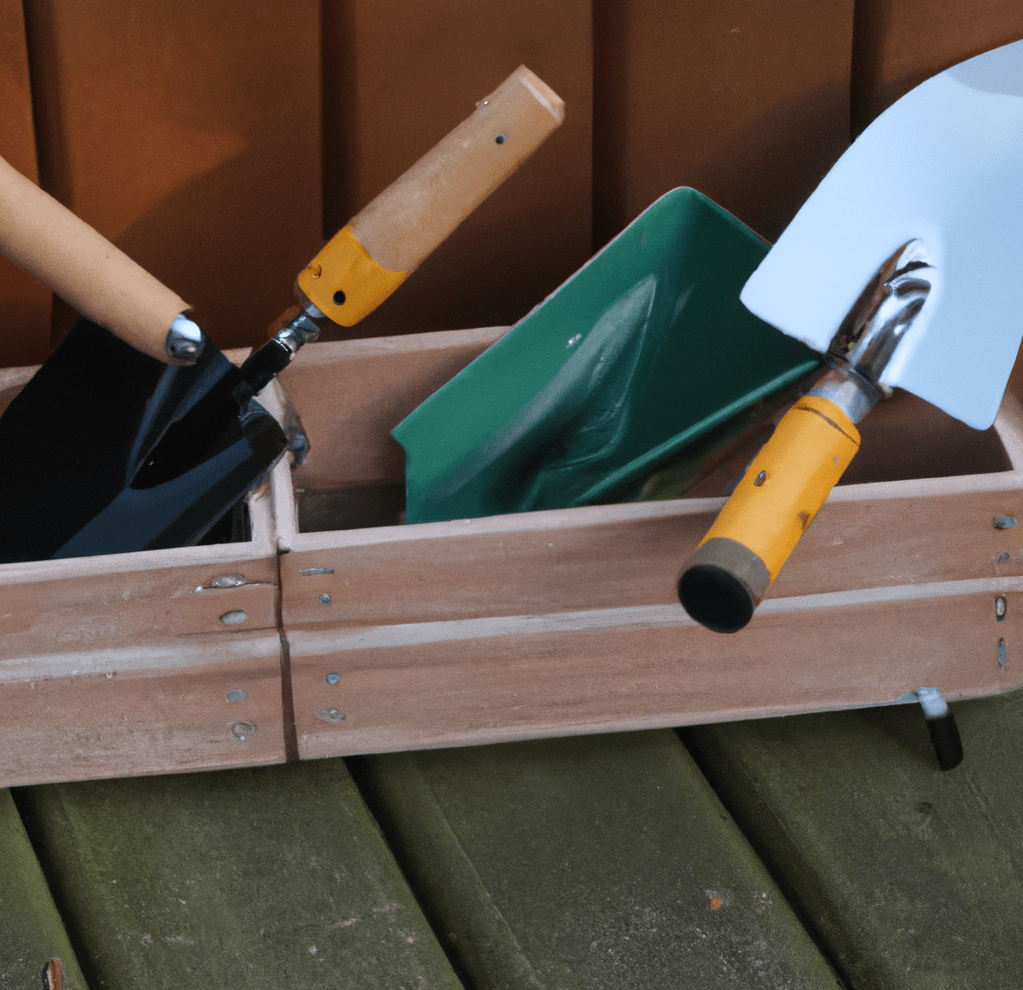
Tips for Selecting the Right Hoe for Your Needs
Now that you’re learning about gardening tools for raised bed gardening, here’s how to choose the right gardening how:
- Consider the type of hoe: There are various hoe types, each with particular characteristics and applications. Choose a hoe that is appropriate for the type of labor you will be performing in your raised bed garden. Draw hoes, scuffle hoes, and stirrup hoes are a few examples of common hoe kinds.
- Find a handle that is comfortable to hold: The hoe’s handle should be comfortable to hold because it might affect your comfort and control while using the tool. Choose a hoe with a handle that is cozy to hold and simple to maneuver. Wood, fiberglass, or other materials can be used to make handles.
- Think about the weight: The hoe’s weight is a crucial consideration as well. While a hoe that is too light could not be sturdy enough for frequent heavy use, a hoe that is too heavy can be challenging to operate. Find a hoe that is balanced and enjoyable to use.
- Waterproof: Look for a hoe that is waterproof or has a rust-resistant coating if you live in a location with frequent rain or high humidity. By doing this, you may keep the hoe from rusting and extend its lifespan.
- Accessories shouldn’t be overlooked: The blade of some hoes can be changed or replaced more easily thanks to additions like detachable heads. Pruners and other accessories can be beneficial additions to your assortment of gardening tools.
You may choose a hoe for your raised bed garden that is ideally suited to your needs and will give years of dependable use by keeping these suggestions in mind when making your selection.
Rake
A rake is a piece of common gardening equipment for gathering leaves, grass clippings, and other trash. This is one of the gardening tools for raised bed gardening that consists of a long handle that is positioned at a right angle to a flat, frequently metal, head. Rakes can have varying numbers and types of tines, as well as different sizes and forms. Rakes serve a variety of purposes in raised bed gardening:
- They can be used to level soil or compost, get rid of trash or plant matter, and cover the bed with mulch or soil evenly.
- Rakes can be used to break up the soil around weed roots, making it simpler to pull them out of the bed. This makes them handy for weeding as well.
Tips for Selecting the Right Rake for Your Needs
When you’re learning about gardening tools for raised bed gardening, there are a few factors to take into account when choosing a rake:
- Rake head’s size and shape: While a narrower head may be preferable for weeding or leveling soil, a wider rake head may be more effective for collecting leaves and other debris.
- Rake head’s construction: metal heads are more resilient and long-lasting.
- Think about the handle’s length and construction: A raised bed’s back can be reached more easily with a longer handle, while a shorter handle may be easier to maneuver in small areas.
- Rake’s weight and durability may also be influenced by the type of the handle: hardwood handles are more lightweight and user-friendly and metal or fiberglass handles are more durable.
- Extra features or accessories that can be useful for your particular needs: Some rakes include detachable heads that make it simpler to swap out or adjust the tines. Others might have add-ons for performing more focused chores, such a wedding spade or metal tines for chopping up tough soil.
You may choose a rake for your raised bed garden that is ideally suited to your needs and will give years of dependable use by taking into account these considerations when making your selection.
Trowel
A trowel is a compact hand-held gardening tool used for planting, weeding, and digging in confined spaces. It normally comprises of a handle, which is frequently constructed of wood or plastic, and a pointed or curved metal blade. For planting individual plants or seedlings this is one of the gardening tools for raised bed gardening. They can also be used to dig holes for bulbs or other small garden accessories. The ability to dig out the roots of weeds and remove them from the bed without upsetting neighboring plants makes trowels useful for weeding as well.
Tips for Choosing the Right Trowel for Your Needs
There are a few factors to take into account while choosing gardening tools for raised bed gardening like a trowel:
- Think about the blade’s size and shape: A larger blade may be more effective for digging deeper holes or working with heavier soils, whilst a smaller blade may be better suited for working in confined spaces or planting smaller plants. As pointed blades are better for digging and curved blades are better for scooping and transporting soil, the shape of the blade can also determine how useful it is.
- Think about the handle and blade’s material: Metal blades tend to be more robust and long-lasting than plastic or wooden ones, but they can also be heavier and more cumbersome to handle. Similar to how metal handles are more durable, wooden or plastic handles may be more lightweight and more comfortable to use.
- Take into account any extra features or accessories that can be useful for your particular needs: For cutting through roots, some trowels feature serrated edges; others could have angled blades or ergonomic handles. When working in the garden, accessories like holsters or sheaths can also be helpful for having your trowel close at hand.
You may choose a trowel for your raised bed garden that is ideally suited to your needs and will give years of dependable usage as an essential garden tool for planting, weeding, and maintaining healthy plants by taking into consideration these characteristics.
Watering Can or Hose
In raised bed gardening, it’s crucial to provide your plants the correct quantity of water to thrive. When thinking about gardening tools for raised bed gardening, watering cans and hoses are the two major items used to water raised bed gardens.
A hand-held garden implement called a watering can have a spout and is used to manually water plants. It normally comes in a variety of sizes and is composed of metal or plastic. A watering can is helpful for spot-watering certain plants or raised bed gardening areas that need more care.
A hose, on the other hand, is a flexible tube that is used to water bigger regions or many plants. A garden hose can be connected to a spigot or other water source, which enables even and regular watering of garden plants.
Tips for Choosing the Right Watering Can or Hose for Your Needs
When you’re choosing between the many gardening tools for raised bed gardening, think about the following for your watering needs:
- Think about the size of your garden and the plant growth circumstances when choosing a watering gadget for your raised bed garden: A watering can be adequate for a small garden or a few plants, but a hose may be preferable for larger gardens or plants that need more water.
- You should also think about the watering tool’s substance: Watering hoses and cans made of plastic are lightweight and convenient, but they might not last as long as metal alternatives. Similar to metal watering cans and hoses, metal items can be heavier and more difficult to maneuver around the garden but are more durable.
- The type of nozzle or spray head, the length, and diameter of the hose, and any additional features like adjustable flow or a built-in filter should all be taken into account when choosing watering equipment: Cultivators can be useful in raised bed gardening in addition to watering equipment for maintaining the health of your plants. A cultivator is a hand-held device used for weeding, loosening, and aerating the soil, and adding compost or other soil conditioners.
- You can make sure that the plants in your raised bed garden receive the proper care they require to survive and produce healthy, vibrant plants by choosing the appropriate watering tool and other gardening tools like a cultivator.
Additional Tools for Raised Bed Gardening
While we’ve covered most of the gardening tools for raised bed gardening, there are others you should know about:
- Garden forks: A hand instrument with multiple tines, a garden fork is used to churn and aerate the soil, mix in compost or other soil nutrients, and pull weeds. Harvesting root vegetables like potatoes and carrots is another application for it. In raised bed gardening, a garden fork is a crucial tool for keeping good soil.
- Garden snips or scissors: these are essential pieces of gardening equipment for trimming and pruning plants. They’re perfect for preserving the shape and health of your plants because they are made for precise cutting of little branches, blooms, and leaves. Garden scissors are suited for smaller branches and stems, whilst hand pruners are used for larger branches and stems. In a raised bed garden, they are perfect for pruning shrubs, trees, and other plants.
- Wheelbarrow: A wheelbarrow is a practical equipment for carrying heavy things like soil, compost, mulch, and more around your garden. Transporting plants, tools, and other gardening supplies can also be done with it.
- Garden Gloves: Garden gloves are necessary to keep your hands safe while working in the garden. They act as a shield between your skin and the sharp objects, thorny plants, and other garden dangers. Pick gloves that fit snugly and are constructed of tough, water-resistant material.
You may increase the effectiveness and pleasure of your raised bed gardening by having these extra tools and supplies on hand. With the appropriate gardening equipment and supplies, you can establish a flourishing garden that yields strong, colorful plants that you can enjoy all through the growing season.
Bottom Line: Gardening Tools for Raised Bed Gardening
You may establish a flourishing garden that yields strong plants and lovely flowers by using the best gardening tools for children or gardeners of any age. We talked about a number of necessary gardening tools for raised bed gardening, such as trowels, hoes, rakes, and watering cans or hoses. We also highlighted a few extra items that can make gardening simpler and more effective, like wheelbarrows, hand pruners, garden forks, and garden scissors.
Consider your unique growth circumstances, the kinds of plants you wish to cultivate, and your own tastes when choosing the correct tools for your raised bed gardening needs. You may develop a lovely and fruitful raised bed garden that will provide you joy for years to come by making an investment in high-quality gardening equipment and supplies.
Gardening Tools for Raised Bed Gardening FAQs
What is gardening in raised beds?
A raised bed that has been stocked with soil is used to cultivate plants in raised bed gardening. Better drainage, soil management, and easier access for planting and weeding are all made possible by this technology.
What instruments are necessary for raised bed gardening?
A hand trowel, garden fork, pruning shears, hand cultivator, and safety equipment such gardening gloves are necessary for raised bed gardening.
Why is a shovel required for planting in raised beds?
Raised bed gardening necessitates the use of a shovel since it can be used to break up and loosen the soil, move dirt, compost, and other materials into the raised bed, mix the two materials, clean the raised bed, and help with harvesting.
What factors need to be taken into account while choosing the best shovel for gardening in raised beds?
The size of the raised bed, the comfort of the handle, the material and shape of the blade, the weight, and the quality should all be taken into account when choosing the best shovel for raised bed gardening.
What is a hoe, and why do raised bed gardeners use them?
A hoe is a long-handled gardening implement for raised bed gardening that breaks up dirt and gets rid of weeds. It has a handle that is tilted at a right angle to the head, which has a flat, blade-like surface.
What’s a rake?
An everyday gardening tool for collecting leaves, grass clippings, and other detritus from a garden or yard is the rake. It features a long handle and a flat, frequently metal, tined head with a range of sizes and shapes. Rakes can be used in raised bed gardening for a variety of tasks, including leveling the soil, removing waste or plant material, and uniformly covering the bed with mulch or soil.
What should I take into account while picking a rake for gardening in raised beds?
The size, shape, and construction of the rake head (metal heads are more durable), the handle’s length and design, the rake’s weight and durability (which may be influenced by the type of handle), and any additional features or accessories that might be useful for your specific needs are all things to take into account when selecting a rake.
What’s a trowel?
An efficient hand-held gardening tool called a trowel is used for planting, weeding, and digging in small places. It often has a handle made of wood or plastic and a metal blade that is either curved or pointed. When planting individual plants or seedlings or digging holes for bulbs or other tiny garden accessories, trowels come in handy. They can dig up weeds’ roots and remove them from the bed without upsetting nearby plants, making them useful for weeding as well.
What should I take into account while picking a trowel for gardening in raised beds?
Consider the handle and blade material (metal tends to be more durable and long-lasting than plastic or wooden ones), the size and shape of the blade (a larger blade may be more effective for digging deeper holes, while a smaller blade may be better suited for planting smaller plants), and any additional features or accessories that may be useful for your specific needs when selecting a trowel.
Which two watering equipment are most important for raised bed gardening?
Watering cans and hoses are the two main watering implements for raised bed gardening.
What’s a watering can?
A hand-held watering can is a gardening tool with a spout that is used to manually water plants. It is often composed of metal or plastic and comes in a variety of sizes. Watering cans are useful for providing targeted irrigation to certain plants or raised bed gardening areas that require greater care.
What’s a hose?
A flexible tube called a hose is used to water greater areas or lots of plants. It allows for even and regular watering of garden plants because it can be connected to a spigot or other water source.
What factors should I take into account when picking a watering can or hose for gardening in raised beds?
Consider factors like the size of your garden and the needs of the plants when selecting a watering can or hose, as well as the material of the watering tool (plastic items are lightweight and convenient, but they may not last as long as metal alternatives), the type of nozzle or spray head, the length, and diameter of the hose, and the number of plants you plan to water.


